The Importance of Hydraulic Hose Maintenance Audits
Learn the importance of Hydraulic Maintenance for heavy machinery. Improve safety and reduce downtime by keeping on top of your preventative maintenance with regular hydraulic hose audits.
The Importance of Hydraulic Maintenance Audits
Understanding the importance of hydraulic hose maintenance audit on your heavy-duty machine’s hydraulic hoses is crucial to your operation continuing to run smoothly and safely. With 37% of unplanned machine downtime being due to hydraulic hose failure, it is critical to understand the power of planned maintenance.
A regular audit programme allows you to Assess, Evaluate and Implement, the required changes potentially before the issue of a blown hose arises.
Implement and stick to a Preventative Maintenance Schedule
Having a schedule for your preventative maintenance is crucial. This will allow you to plan ahead and integrate it with the scheduled maintenance of your hydraulic machinery. By sticking to a preventative maintenance schedule, you always have up-to-date data on each machine. This allows you to make informed decisions giving you greater control throughout your operation.
The benefits of regular preventative maintenance go far beyond reducing the risk of hoses blowing frequently. They are focused on the safety of the operator, workers on site, and protecting the environment.
With machines able to operate with less interruption, workers are able to complete projects and meet deadlines reducing the stress from overtime and weekend work. Well-performing machines perform at their best when it matters the most (during work hours).
Machines kept in top working order through preventative maintenance avoid oil leakage and loss, preventing contamination of the ground and surface water.
Create an Audit Report
A well-thought-out Audit Report will allow you to document the state of your hydraulic hoses, giving you the ability to determine the need for immediate and/ or long-term repairs & modifications. This can be as simple as a document, which allows you to jot down the state of each hydraulic hose line on your hydraulic machine, giving you the ability to prioritize the replacement of these hoses, depending on the priority ranking you put the hose under – immediate, medium or can wait.
1. Immediate – This hose needs to be immediately rectified. >300 hours
2. Medium – This hose needs addressing but not urgently. >1200 hours
3. Can wait – This hose can wait. >4000 hours
Complete your Audit report during your scheduled preventative maintenance and refer back to previous Audit reports to identify any reoccurring issues or areas of concern.
You should be inspecting your hoses every 3 months or every 400-600 hours whichever comes first, however keep a closer eye on them following extreme operating temperatures or hoses that are used for critical equipment.
Calculate your potential saving here as well if you implement preventative maintenance to your heavy machinery.
Remember the following:
- Don’t ignore leakages
- Replace the old or damaged hose and fittings as per the priority ranking previously mentioned.
- Prevent contamination of the environment by watching for oil leakage.
- The pressure rating of a hose should not be exceeded.
- Always maintain the correct temperature of hydraulic fluid for the specific hose. These can be different for different hoses.
- Hydraulic equipment that is taken care of will last longer and offer a safer working environment.
By planning for the unplanned, companies turn wasted time back into profit and keep their personnel engaged and safe on the job.
It’s never too late to rethink and restart your hydraulic hose repair and maintenance programme.
Contact the team at BOA Hydraulics to transition towards preventative hydraulic hose maintenance for greater savings, success, and Hydraulic Uptime.
